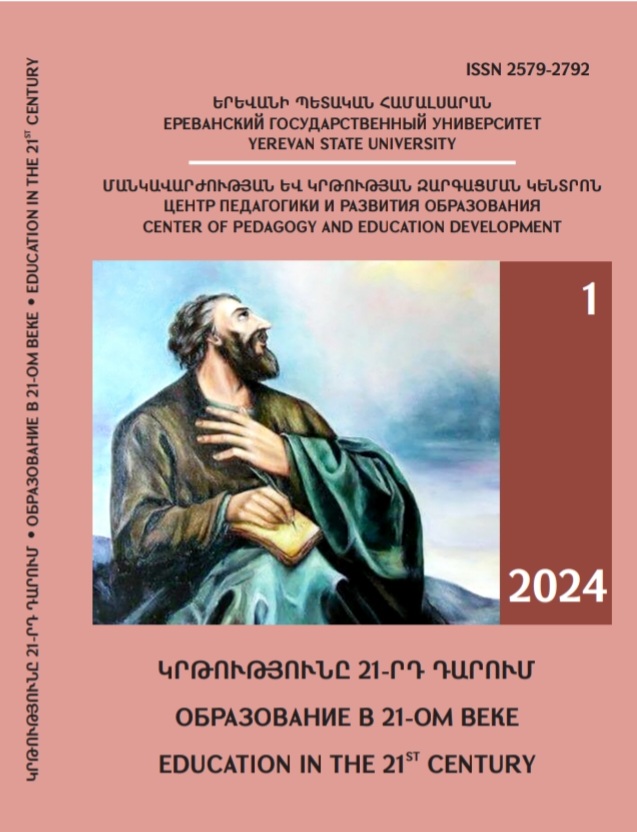FEATURES OF APPLYING THE COMPARATIVE ANALYSIS METHOD IN PEDAGOGICAL RESEARCH
DOI:
https://doi.org/10.46991/ai.2024.1.35Keywords:
comparative studies, methods and principles of comparative pedagogy, comparative analysis, pedagogical research, comparative pedagogy, comparative educationAbstract
Article is devoted to the consideration of the features and significance of the comparative analysis method in the context of pedagogical research. The method of comparative analysis is an important tool in educational research, allowing for a systematic comparison of various factors, historical contexts or teaching phenomena. This method allows researchers to identify differences, similarities and influences of various variables on educational processes. When using a comparative analysis method, it is important to consider the context and objectives of the study, and to carefully select parameters for comparison so that the results are representative and informative. In educational research, this approach makes it possible to identify the effectiveness of educational practices, compare the learning outcomes of different groups of students, or evaluate the impact of different teaching methods on educational achievements.
The purpose of this article is to analyze and systematize the method of comparative analysis in pedagogical research in order to identify its key features, advantages and practical capabilities.
The novelty of this study is determined by the significance of the problem being studied and the insufficient development in Armenia of the main approaches of comparative studies in pedagogical research. The method of comparative analysis in pedagogical research always remains relevant, allowing one to identify differences and similarities between different educational approaches, teaching methods, curricula, etc. Comparative analysis contributes to a deeper understanding of the effectiveness of pedagogical approaches, methods, techniques, tools, etc. . and helps identify best practices in education. This method not only allows us to identify the strengths and weaknesses of educational systems, but also contributes to the development of recommendations for improving the quality of education.
The author also presents practical recommendations for the effective use of this method in pedagogical research.
References
Андриенко Е. В., СРАВНИТЕЛЬНАЯ ПЕДАГОГИКА, Мин-во образования и науки РФ, Новосиб. гос. пед. ун-т. – Новосибирск: Изд-во НГПУ, 2016. – 209 с.
Бражник Е. И., Особенности методов сравнительных педагогических исследований // Исследовательская культура: методы, приемы, процедуры. – СПб.: РГПУ, 2005. – 267 с.
Вульфсон Б. Л., Сравнительная педаго¬гика: история и современные проблемы. – М.: Изд-во УРАО, 2003. – 232 с.
Джуринский А. Н., Сравнительная педагогика. – М.: Издательство Юрайт, 2014. – 440 с.
Иванов О. Б., Иванова С. В., Формирование современного образовательного пространства: междисциплинарный взгляд [Электронный ресурс] // Философские науки. – 2016. – № 1. – С. 39–49. – URL: https://elibrary.ru/ download/elibrary_25795006_24761178.pdf
Кучеревская М.О., Шаляпин О.В., ЭВОЛЮЦИЯ ПОДХОДОВ К ОРГАНИЗАЦИИ СРАВНИТЕЛЬНО-ПЕДАГОГИЧЕСКИХ ИССЛЕДОВАНИЙ //Сибирский педагогический журнал ♦ № 3 / 2019, С. 140-150. ( DOI: 10.15293/1813-4718.1903.14)
Мандель Б. Р., Сравнительная педагоги¬ка: история, теория, проблематика. – М.; Берлин: Директ-Медиа, 2019. – 573 с.
Downloads
Published
How to Cite
Issue
Section
License
Copyright (c) 2024 Tigranuhi Hakobyan

This work is licensed under a Creative Commons Attribution-NonCommercial 4.0 International License.

